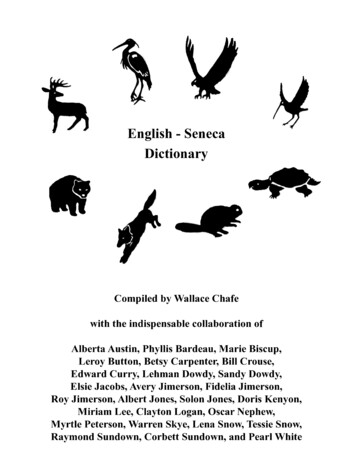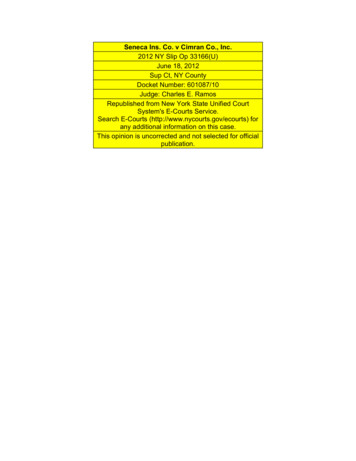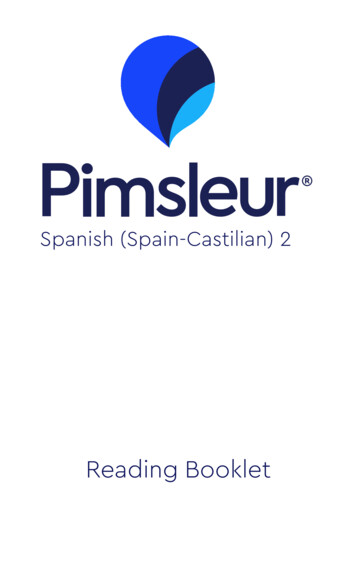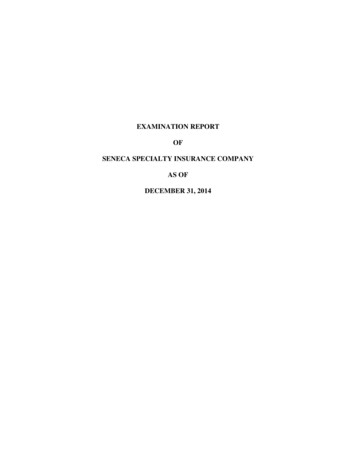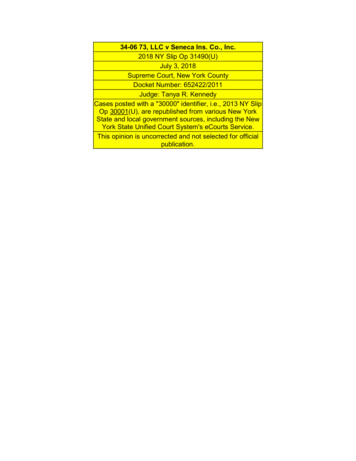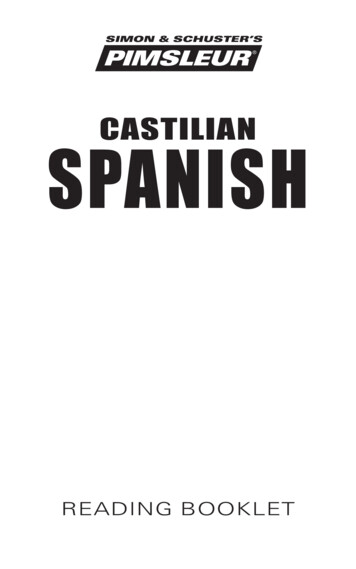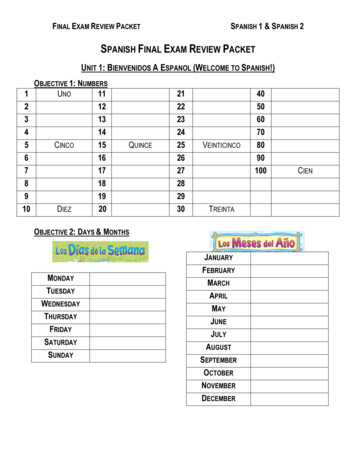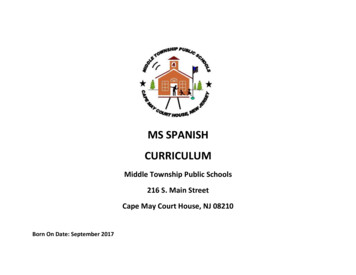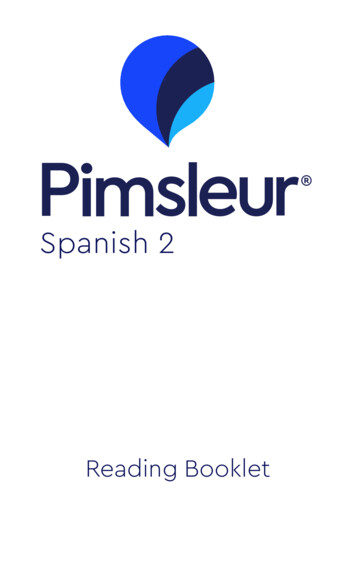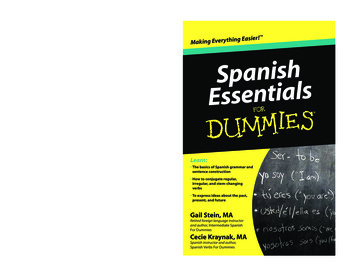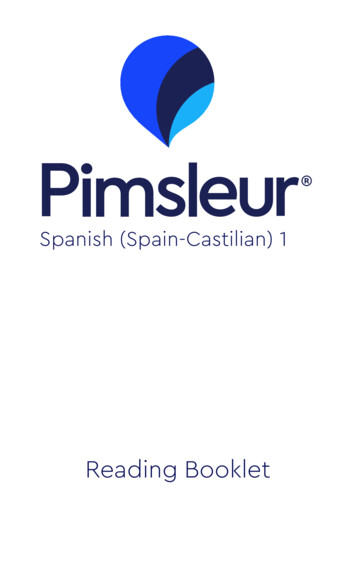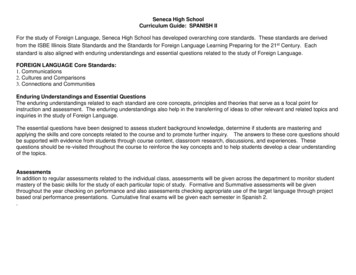
Transcription
Seneca High SchoolCurriculum Guide: SPANISH IIFor the study of Foreign Language, Seneca High School has developed overarching core standards. These standards are derivedfrom the ISBE Illinois State Standards and the Standards for Foreign Language Learning Preparing for the 21st Century. Eachstandard is also aligned with enduring understandings and essential questions related to the study of Foreign Language.FOREIGN LANGUAGE Core Standards:1. Communications2. Cultures and Comparisons3. Connections and CommunitiesEnduring Understandings and Essential QuestionsThe enduring understandings related to each standard are core concepts, principles and theories that serve as a focal point forinstruction and assessment. The enduring understandings also help in the transferring of ideas to other relevant and related topics andinquiries in the study of Foreign Language.The essential questions have been designed to assess student background knowledge, determine if students are mastering andapplying the skills and core concepts related to the course and to promote further inquiry. The answers to these core questions shouldbe supported with evidence from students through course content, classroom research, discussions, and experiences. Thesequestions should be re-visited throughout the course to reinforce the key concepts and to help students develop a clear understandingof the topics.AssessmentsIn addition to regular assessments related to the individual class, assessments will be given across the department to monitor studentmastery of the basic skills for the study of each particular topic of study. Formative and Summative assessments will be giventhroughout the year checking on performance and also assessments checking appropriate use of the target language through projectbased oral performance presentations. Cumulative final exams will be given each semester in Spanish 2.
Seneca High SchoolCurriculum Guide: SPANISH IICourse of Study : Spanish Core Standard: CommunicationStandards21st Century1.1, 1.2, 1.3ISBE Goals:28 A, B, C, DEnduring Understandings All of the following aspects of communicationhelp to develop and reinforce an understandingand application of the target language:Oral and written conversation(Intrapersonal)Listening and reading to a variety ofcommunication formats (Interpretive)Presenting information (Presentation)Essential Questions What are the benefits to being able tocommunicate in another language? How are words, phrases & sentences differentand similar in English and the targetlanguage? How well can a person interact with a nativespeaker in the target language? How does one express preferences, feelings,emotions, and opinions in detail in the targetlanguage?SkillsKey Content1. The students will demonstrate a proficiency to communicate preferences,feelings, emotions and opinions in the foreign language.2. The students will apply knowledge of the target language to conversationswith others and to the exchange of ideas.3. The students will be able to translate sentences and phrases from theforeign language to English and from English to the target language.4. Students will compare similarities and differences between variousgrammar elements of English and the target language.Resources/Text CorrelationLevel: 21. Vocabulary knowledge over different topics.2. Grammatical application of present, present progressive,imperfect progressive, preterite and imperfect tenses.3. Translation from one language to another (orally and in writing)4. Sentence and grammar structure orally, and in writingInstructional Strategies/Best Practices1. Students will do Activities from the book andKey Criteria/Benchmarks for SuccessVocabulary, grammar and oral quizzes.Realidades textbook, workbook, videos,workbooks.Cds.Chapter Tests, and Final Exams.2. They will write and answer questions out-loud andin writing.Special projects and presentations asTechnology sites (Duolingo, Colby.edu etc.)3. They will compare and express preference aboutassignedby theMagazines, newspapersCourseand otherof Study : SpanishCore Strand: Cultural ComparisonsLevel:1 instructor.objects, activities and ideas in writing and out-loud.resources4. They will translate out-loud the questions theymake or their answers.Videos through YouTube5. They will learn how to conjugate verbs.
Seneca High SchoolCurriculum Guide: SPANISH IICourse of Study : SpanishStandardsCore Standard: Cultures & ComparisonsEnduring Understandings21st Century:2.1, 2.2, 4.1, 4.2Cultural comparisons help one to understand the world bydeveloping tolerance and appreciation of other cultures.ISBE Goals:29 A, B, C, D, ECultural comparisons help the students understand thatlanguage is a tool that can be used to communicate withothers.Level: 2Essential Questions1. What is considered polite and/or impolite behavior in thetwo cultures?2. What are typical pastimes in the foreign culture? Howare they similar or different from those in America?3. What celebrations do the two cultures share and whichones do they not share? What traditions have influencedthe English-speaking world?4. Are there settlements and geographical evidence in theU.S. that point to the foreign country?5. How does the study of language help to improve globalrelations?SkillsKey Content1. The student will be able to use: greetings and farewells; and will be able to address people in thetarget language.2. The student will be able to accept and/or decline an invitation; how to order at a restaurant; howto buy at a store or market; how to give orders in the target language.3. The student will compare pastimes and leisure activities of the target language countries to thoseof the United States,4. The student will compare celebrations in the target cultures to those in the United States5. The student will realize that being able to communicate with others helps understanding them andtheir culture. This understanding will be conducive to the improvement of relations betweencultures.6. Students will analyze how various cultures have influenced different parts of the United States.7. The students will evaluate how the study of a foreign language is beneficial to global relations.1. Vocabulary associated with everyday activities.2. Affirmative Regular and Irregular Tú commands3. Readings about daily activities in the target languagecountries.4. Discussions of influences of the target culture indifferent parts of the United States.5. Study of different jobs where the target language isused (business, government, etc.)Resources/Text CorrelationRealidades textbooks, videos,workbooks, Cds.Technology internet sites, You tube videosNewspaper and magazine articlesInstructional Strategies/Best Practices1. Vocabulary associated with everyday activities.2. Affirmative Regular and Irregular Tú commands3. Readings about daily activities in the targetlanguage countries.4. Discussions of influences of the target culture indifferent parts of the United States.5. Study of different jobs where the target languageis used (business, government, etc.)Key Criteria/Benchmarks for Success1. Quizzes, Chapter tests, Presentation Projectsand Final Exams.
Seneca High SchoolCurriculum Guide: SPANISH IICourse of Study: SpanishStandardsCore Standard: Connections & CommunitiesEnduring Understandings21st Century: 3.1, 3.2, 5.1, 5.ISBE: 30 A, BLevel: 2Essential QuestionsIn what ways are the other subject areas in the curriculumaffected by the study of a world language?The study of language applies to many different contentareas.What are some ways you can make connections betweenthe target language and the other subject areas?SkillsKey ContentThe students will enhance, review or expand their knowledge in the following areas: English,Social Studies, Art, Technology, P.E., Math.In English, the students will compare and contrast their knowledge of English in the following areas with what theyare learning in the target language.In grammar -The students will learn about or review the parts of speech, the concept of reflexive verbs, the verb tenses.In writing, the student will use and compare the writing mechanics of the two languages with respect topunctuation, capitalization, and the creation of compound sentences by using conjunctions.In reading, comprehension in both languages is developed by reading out loud, dramatizing what they read andanswering questions about the excerpts used.In literature, students will compare literary movements and literary figures in the target language to English. SocialStudies - Students will examine the geography, history, civilization, culture, historical figures, and music of the targetlanguage and will compare it with their own.Art - Students will evaluate art in the countries of the target language by getting acquainted with painters, musicians,artistic movements and indigenous art of the target culture and identify common characteristics and how they comparewith the same elements in the English /American culture.Technology- Students will apply technology research skills to the study and review of the target language.Physical Education - Students will compare sports and recreation in other countries to their own. Mathematics Students will know numbers 0 through the millions.Resources/Text CorrelationRealidades Level II- textbook, workbook, videos,CDsTechnology Internet Sites, YouTube videosNewspaper articles, magazines and other outsideresourcesInstructional Strategies/Best PracticesHave students learn vocabulary, read and write inthe target language about the different disciplines.Have students listen to and read all numbers in thetarget language. Have students listen to songs inthe target language.Have students develop assigned projects related tothe topics that bring real life application using thetarget language.1. Vocabulary associated with differentsubjects, Math, Science, ComputerTechnology, Medicine, Art etc.2. Geographic knowledge of countrieswhere the target language isspoken.3. Famous Artists, their paintings andartistic styles (art movements suchas cubism and Picasso, surrealismand Dali)4. Study of history and famous peopleof the target language5. Poems, short stories and readings oforiginal works in the targetlanguage.6. Study of Famous people and theiraccomplishments in other disciplinessuch as sports, government, etc.Key Criteria/Benchmarks for SuccessQuizzes, Chapter tests, PresentationProjects and Final Exams.Special projects as assigned by the teacher
Seneca High SchoolCurriculum Guide: SPANISH II# BJECTIVE21st Century 1.1, 1.2, 1.3, 2.1, 2.2, 3.1,4.1, 4.2, 5.1, 5.2State: 28 A, B, C, D 29 A,B, C, D, E 30A, B1A21st Century 1.1, 1.2, 1.3, 2.1, 2.2, 3.1,4.1, 4.2, 5.1, 5.2State: 28 A, B, C, D 29 A,B, C, D, E 30A, B6-8 Days1B21st Century 1.1, 1.2, 1.3, 2.1, 2.2, 3.1,4.1, 4.2, 5.1, 5.2State: 28 A, B, C, D 29 A,B, C, D, E 30A, BESSENTIAL SKILLS/KEY CONTENTAlphabet ReviewClassroom VocabularyNoun/Adjective agreementPresent Tense and SerConjugation of Regular Verbs in the present tense and be able to write/expresscurrent actionsKnowing how to form questions using the Spanish words: what, how, when,why, etc.Hispanic geographyVerbs with Irregular “Yo” formsConjugation of Stem Changing Verbs in the present tense.Affirmative and Negative WordsTener review and yo form changers in presentClassroom rules and Activities Vocabulary and Reviewfrom last yearVerb “IR” in present tenseVocabulary associated with free time and ExtracurricularActivitiesComparisonsSaber vs. ConocerExpressing how long something has been happening
Seneca High SchoolCurriculum Guide: SPANISH II6-8 Days2A21st Century 1.1, 1.2, 1.3, 2.1, 2.2, 3.1,4.1, 4.2, 5.1, 5.2State: 28 A, B, C, D 29 A,B, C, D, E 30A, B6-8 Days2B21st Century 1.1, 1.2, 1.3, 2.1, 2.2, 3.1,4.1, 4.2, 5.1, 5.2State: 28 A, B, C, D 29 A,B, C, D, E 30A, BHow to use an infinitive verb form after a conjugated verb.To know how to conjugate reflexive verbs and when to use them such asdiscussing daily routines.To understand the differences between Ser and Estar, and how to conjugate themin the present tense.To be able to use possessive adjectives and make them agree with the noun theyare modifying.Be able to use body parts and clothing items in target languageUnderstand some cultural differences in clothing items and dressing habits suchas the use of the Poncho in some areas of Spanish speaking countries.Know how to count in Spanish into the millions if necessaryBe able to express past actions using the regular preterite of AR,ER and IRverbs in written, oral and listening skills.Be able to conjugate and use the preterite “YO” form changers –CAR, -GAR,and –ZAR ending verbs.Be able to ask for assistance in shopping situations in the target language.Understand the three types of Demonstrative adjectives and how to make themagree with the noun they are modifying.Understand how to make an adjective become a pronoun by dropping the nounKnowing about products used in other countries and the U.S.Understand that languages have similarities and origins of words can come fromother languages.
Seneca High SchoolCurriculum Guide: SPANISH II6-8 DaysstCHAPTER 21 Century 1.1, 1.2, 1.3, 2.1, 2.2, 3.1,4.1, 4.2, 5.1, 5.23AState: 28 A, B, C, D 29 A,B, C, D, E 30A, BStudents will be able to answer and ask questions using time vocabulary.Understand what the direct object pronouns are that relate to humans and objects(lo, la, los, and las) and how to express and write them in SpanishKnow how to conjugate and express past actions using irregular preterite verbs.Read and understand short readings and poetry in SpanishDiscuss hispanic holidays and compare/contrast them to ours.Understand differences in Spain and Latin American shopping as well aspharmacies and prescription requirements and why.Project: Famous latino appreciation project that incorporates all skills in Spanishand English.1-2 daysFINAL6-8 Days3BAll Standards Addressed21st Century 1.1, 1.2, 1.3, 2.1, 2.2, 3.1,4.1, 4.2, 5.1, 5.2State: 28 A, B, C, D 29 A,B, C, D, E 30A, BReview & give Cumulative Final ExamReview Present Tense verbs with irregular “yo” conjugations (-Go verbs)Understand the Direct Object Pronouns that only relate to humansKnow how to give affirmative commands in the Tú familiar conjugationsUnderstand the Present Progressive Tense in Spanish and compare it to theEnglish constructionUnderstand cultural issues in regard to transportation in the Spanishspeaking world.
Seneca High SchoolCurriculum Guide: SPANISH II6-8 DaysstCHAPTER 21 Century 1.1, 1.2, 1.3, 2.1, 2.2, 3.1,4.1, 4.2, 5.1, 5.24AState: 28 A, B, C, D 29 A,B, C, D, E 30A, B6-8 DaysstCHAPTER 21 Century 1.1, 1.2, 1.3, 2.1, 2.2, 3.1,4B4.1, 4.2, 5.1, 5.2State: 28 A, B, C, D 29 A,B, C, D, E 30A, BKnow how to express diminutives and superlatives using Spanish suffixes.Understand how to conjugate the Imperfect Tense in Spanish and the basicdifferences with the Preterite TenseUnderstand what an Indirect Object Pronoun is in Spanish. Compare the Spanishsentence construction to the English sentence construction.Be able to speak, read, write and listen to vocabulary associated with childhoodand to present basics about what their childhood was like.Have a basic understanding of some rhymes and songs that are part of the cultureof the target language.Be able to communicate about family relations and holiday celebrations in thepresent and past tense as well as communicate and understand cultural differencesin manners and greetings.Know how to express reciprocal actions using plural Reflexive pronounsRead about and understand about the different languages and dialects inSpain. Compare this to other countries that speak multiple languages.An understanding and appreciation for cultural diversity on holidays andspecial events that are celebrated in different areas of the target language.
Seneca High SchoolCurriculum Guide: SPANISH II6-8 DaysstCHAPTER 21 Century 1.1, 1.2, 1.3, 2.1, 2.2, 3.1,4.1, 4.2, 5.1, 5.25AState: 28 A, B, C, D 29 A,B, C, D, E 30A, BStudents should be able to use the vocabulary from the chapter in regard todisasters through spoken, written and listening.Students should be able to describe an event in the past tense that occurred usingthe target language.Read and discuss about holidays in the target culture. Compare the differences inthe celebrations with our cultureUnderstand the “tener” expressions and how they compare to the Englishequivalents “to be hungry, tired, etc.Understand how to conjugate the irregular orthographic spelling of Preteriteverbs using “y” (double vowel changes in preterite)Students should have a basic understanding of hardships associated withnatural disasters and tragedies in various cultures as well as how legendscan be formed out of these natural environment changes.6-8 DaysstCHAPTER 21 Century 1.1, 1.2, 1.3, 2.1, 2.2, 3.1,4.1, 4.2, 5.1, 5.25BState: 28 A, B, C, D 29 A,B, C, D, E 30A, BStudents can describe an injury and or the scene of an accident in the past tenseusing the target language in a variety of ways.Students should now know almost all of the major body parts in the targetlanguage vocabulary.Conjugate Irregular Preterite VerbsUnderstand the Imperfect Progressive Tense, how it compares to the EnglishImperfect Progressive, and how to use it as background description with aninterrupting action expressed in the Preterite tense.
Seneca High SchoolCurriculum Guide: SPANISH II6-8 DaysstCHAPTER 21 Century 1.1, 1.2, 1.3, 2.1, 2.2, 3.1,4.1, 4.2, 5.1, 5.26AState: 28 A, B, C, D 29A,B, C, D, E 30 A, BStudents are able to discuss television shows and movies in the target languagein a variety of ways.Understand the cultural perspectives in regard to television and movies in theSpanish speaking world.Understand the verb constructions using Indirect Object Pronouns (Like gustar,encantar). Students should understand the difference when translating “I like.”.Conjugate and understand the IR stem changing verbs in the Preterite tense.Learn how to express the idea “to get” or “to become” using the Reflexive verbconstruction.6-8 DaysstCHAPTER 21 Century 1.1, 1.2, 1.3, 2.1, 2.2, 3.1,4.1, 4.2, 5.1, 5.26BState: 28 A, B, C, D 29 A,B, C, D, E 30A, BBe able to use the target language in a variety of ways in reference to movieplots, characters, and opinions.Learn how to conjugate and express the Present Perfect tense. Compare the verbconstruction to the English equivalent.Students will gain a better understanding of the use of indirect object pronouns inthe target language.Basic understanding of the cultural aspects in regard to cinema in the Spanishspeaking world.
Seneca High SchoolCurriculum Guide: SPANISH II2-3 DaysChapter7A21st Century 1.1, 1.2, 1.3, 2.1, 2.2, 3.1,4.1, 4.2, 5.1, 5.2State: 28 A, B, C, D 29 A,B, C, D, E 30A, BThis chapter will not be completed but information and objectives will becovered but not necessarily mastered.Students will review and cover new yo form changing verbs in the present tense.Students will review and cover new vocabulary dealing with foods, beveragesand cooking for all the meals of the day.Students will be able to express negative tu commands in telling people what notto do in the target language.Students will understand the cultural perspectives on recipes and foodpreparation in the Spanish speaking world.1-2 DaysRepaso/ExamAll Standards AddressedReview & give Cumulative Final Exam
Seneca High SchoolCurriculum Guide: SPANISH IIILLINOIS ISBE STANDARDS FOR FOREIGN LANGUAGESCOMMUNICATIONCOMPETENCY GOAL 28: Use the target language to communicate within and beyond the classroom setting.A) Understand oral communications in the target languageB) Interact in the target language in various settingsC) Understand written passages in the target languageD) Use the target language to present information, concepts and ideas for a variety of purposes to different audiences.CULTURE AND GEOGRAPHYCOMPETENCY GOAL 29: Use the target language to develop an understanding of the customs, arts, literature, history and geographyassociated with the target language.A) Understand manners and customs of various target language societies.B) Understand music, dance, folk art, visual art, drama, and architecture related to the target language societies.C) Understand literature and various media of target language societies.D) Understand history of areas the target language is spoken.E) Understand geography of the various target language societies.CONNECTIONS AND APPLICATIONCOMPETENCY GOAL 30: Use the target language to make connections and reinforce knowledge and skills across academic,vocational, and technical disciplines.A) Use the target language to reinforce and further knowledge of other disciplines.B) Use the target language to demonstrate knowledge and understanding of a variety of career options.
Seneca High SchoolCurriculum Guide: SPANISH IISTANDARDS FOR FOREIGN LANGUAGE LEARNING: Preparing for the 21st CenturyCOMMUNICATION: Communicate in Languages Other than EnglishStandard 1.1: Students will engage in conversations, provide and obtain information, express feelings and emotions, and exchangeopinions.Standard 1.2: Students understand and interpret written and spoken language on a variety of topics.Standard 1.3: Students present information, concepts, and ideas to an audience of listeners or readers on a variety of topics.CULTURES: Gain Knowledge and Understanding of Other CulturesStandard 2.1: Students demonstrate an understanding of the relationship between the practices and perspectives of the culture studied.Standard 2.2: Students demonstrate an understanding of the relationship between the products and perspectives of the culture studied.CONNECTIONS: Connect with Other Disciplines and Acquire InformationStandard 3.1: Students reinforce and further their knowledge of other disciplines through the foreign language.Standard 3.2: Students acquire information and recognize the distinctive viewpoints that are only available through the foreign languageand its cultures.COMPARISONS: Develop Insight into the Nature of Language and CultureStandard 4.1: Students demonstrate understanding of the nature of language through comparisons of the language studied and theirown.Standard 4.2: Students demonstrate and understanding of the concept of culture through comparisons of the cultures studied and theirown.
Seneca High SchoolCurriculum Guide: SPANISH IICOMMUNITIES: Participate in Multilingual Communities at Home & Around the WorldStandard 5.1: Students use the language both within and beyond the school setting.Standard 5.2: Students show evidence of becoming life-long learners by using the language for personal enjoyment and enrichment.
Seneca High SchoolCurriculum Guide: SPANISH II
Seneca High School Curriculum Guide: SPANISH II . Studies - Students will examine the geography, history, civilization, culture, historical figures, and music of the target . Realidades Level II- textbook, workbo
